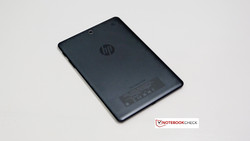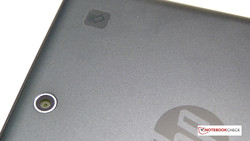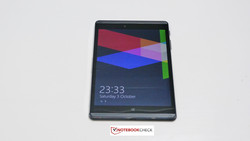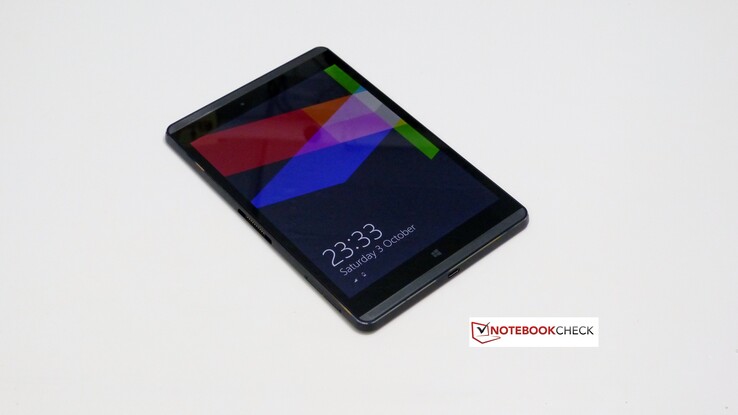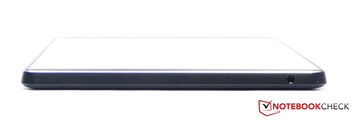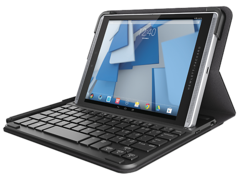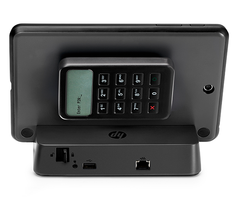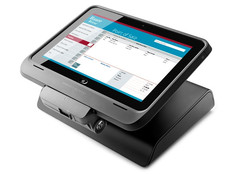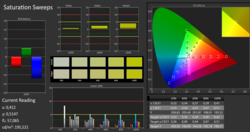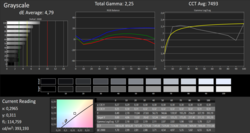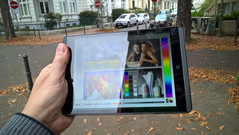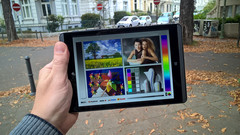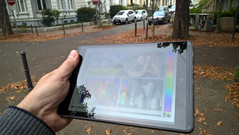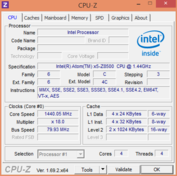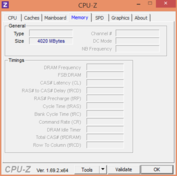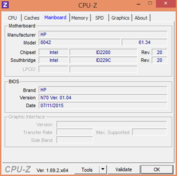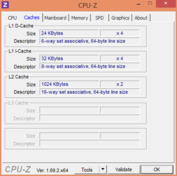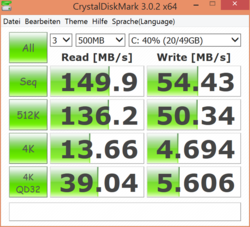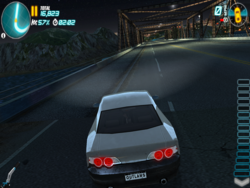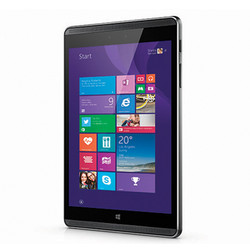HP Pro Tablet 608 G1 Tablet Review
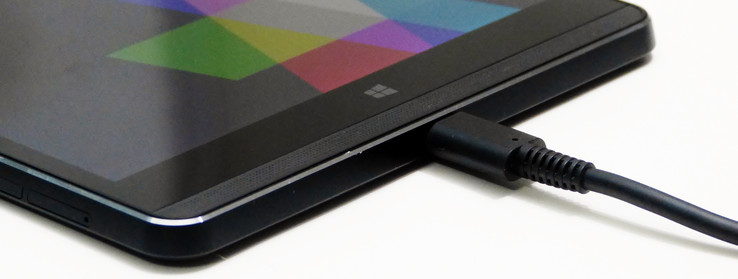
HP have raised the bar for the 8-inch Windows tablet category by introducing the HP Pro Tablet 608 G1 with a laptop-like specification set that includes a 2048 x 1536 pixel 4:3 ratio screen with digitizer, and a docking port that supports some interesting accessories. This strong all-rounder looks good but for consumers though this is an expensive choice and one that doesn't appear to offer much more in terms of performance than Windows tablets that cost under $200. At $699 for the high-end model you'll need to give it careful consideration. Even the entry-level model is an expensive choice. $429 brings only 2 GB RAM and 32 GB storage and you won't even get a USB-C adapter with it. Let's take a closer look though to see what 'pro' level features HP think are worth paying for.
Case
The HP Pro Tablet 608 G1 has a unique styling among 8-inch Windows tablets. Not only is this one of the few 4:3 tablets around but the design, with angled edges, chrome piping and landscape-focused layout, feels like premium quality. The USB-C port and docking port sit tidily along with the only other port, the headset connector. Closer inspection reveals a well-covered MicroSD and SIM card slot and array mics. What a shame then that HP didn't manage to expend that quality to two sloppily attached stickers on the back of the unit. One of these stickers indicates NFC support which gives us our first hint that there's a little bit more going on inside than on a consumer Windows tablet.
A metal frame gives the HP Pro 608 G1 a strong, sturdy feel to it but that's also because this is a relatively bulky tablet. 8.4 mm is over 2mm thicker than an iPad Mini 4 and the weight of 420 grams is also at the heavier end of the scale. Compared to other 'pro' Windows tablet options though, the Lenovo Thinkpad 8 comes to mind, it's comparable and consideration must be given to what's available inside. We'll talk more about that below.
Connectivity
You won't find an HDMI port, you might miss the hidden MicroSD slot and there's only one USB port which might confuse and even annoy some people because it's a USB-C port that only supports USB 3.0 (not USB 3.1 with power delivery) and charging. You won't even find an adapter cable in the box so unless you're an early adopter on the USB-C scene you'll probably get as caught out as we did when we tried to transfer our test files onto the tablet. Given that an adapter cable is required for nearly all 8-inch Windows tablets it's not as bad as it seems but it's annoying that HP didn't include this relatively low-cost accessory.
In addition to USB-C you get a 10-pin docking connector which is the gateway to accessories that show exactly where HP is aiming this tablet.
There are four retail and mobile retail docking and case solutions available, a business docking station, two keyboard types, a sleeve, smart cover a rugged case being shown in the accessory range and we suspect there are other solutions available on a project-by-project basis. It's unclear to us what protocols are running over the docking port but USB 3.0 would be the minimum requirement here.
Communication
A high-end Intel Dual Band Wireless-AC 7265 module is included which brings 802.11ac, WiDi and Bluetooth and supports dual bands and dual channels. NFC and three cellular options (depending on country) cover all wireless connectivity options. GPS is included with the cellular modems.
We tested the HP Pro Tablet 806 G1 WiFi alongside a Surface Pro 3 and at 3 meters from the AC WiFi hotspot we were able to transfer a file from a network-connected drive at a sustained 30 MB/s which is about the same as the Surface Pro 3. Moving away from the router saw the HP Pro Tablet 608 G1 performance drop very quickly though. At about 10 meters the performance had dropped to just 3 MB/s while the Surface Pro 3 was still able to sustain a 10MB/s transfer rate.
Security
Although HP don't offer a VPro option on the Pro 608 G1 there's a TPM module and, with Windows Pro versions, Bitlocker disk encryption.
Input Devices
Touchscreen
The high-resolution touchscreen has an anti-smudge covering and has a digitizer layer for pen input. We weren't able to test the digitizer in this review. Windows 8 / 10 Store apps are all well optimized for high-DPI screens and we had no problems with touch control. The 4:3 format also lends itself to portrait mode thumb typing and the side-mounted speakers help as grip-points for one-handed touch input in landscape mode. Contrast, as you'll see in the results below, was very good which also helps touchscreen usability.
Display
The 2048 x 1536 display is sharp, bright and above average for the 8-inch Windows 8 category and even something new for the 'pro' category. The Lenovo Thinkpad 8 offered just a 1920 x 1200 screen. It's difficult to asses just how much of an advantage the resolution is and one must consider the impact on performance and battery life that comes with such a high resolution screen.
It's a glossy screen and also integrates a digitizer layer for pen support (not supplied) and 10-point touch. Wide viewing angles and high brightness will help in scenarios such as retail and transport where lighting can be extreme.
Take a look at the graphic below to see our test results. Average maximum brightness was 377 nits with a maximum of 406 measured on the top left. We measured just 316 nits at the center on battery life though so be aware of that. Also be aware that high brightness levels can greatly impact battery life.
| |||||||||||||||||||||||||
Brightness Distribution: 86 %
Center on Battery: 316 cd/m²
Contrast: 792:1 (Black: 0.49 cd/m²)
ΔE Greyscale Calman: 4.79 | ∀{0.09-98 Ø5}
Gamma: 2.25
CCT: 7493 K
Black levels weren't exceptional but the high brightness resulted in a contrast ratio of 792:1 which isn't bad. Unfortunately we weren't able to measure color accuracy or coverage out as we didn't have the required USB-C adapter to hand when we did the testing. We were able to test greyscale levels and saw a deviation of 4.79 and a an average white level of 7493 which is towards the blue end of the spectrum. A side-by-side comparison with the Surface Pro 3 definitely confirmed this. Colors where comparable, to the eye, in the same side-by-side test.
Performance
The Intel Atom X5 Z8500 processor, specifically designed for tablets on a 14 nm process includes a GPU and video codec hardware, support for Turbo Boost up to 2.24 Ghz (single CPU core) and a Gen 8 GPU that runs between 200 and 600 Mhz also depending on thermal headroom. In comparison with previous generation Intel Atom processors this has a similar per-clock CPU power but an improved GPU that can help gaming and other 3D graphics operations. The CPU can support up to 8 GB of RAM but is paired here with 4 GB.
Processor
We've run a suite of tests on the Atom X5 Z8500 processor that include CPU loads, synthetic GPU tests and a few games. In general it looks like the X5 doesn't have enough thermal headroom to be able to offer the full performance of the platform. This could be becuase of the high module count (LTE, GPS, NFC and big battery in this model) or a conscious decision by HP to offer a cooler-running system with slightly longer battery life.
In our Cinebench tests below you'll see that the single-core CPU tests result is the same across the selection but when we get to the multi-CPU score there's a big variation. The HP Pro Tablet 608 G1 under-performs the Surface Pro 3 by a big margin and yet it outperforms the HP Elitepad 1000 G2 with Z3795 on the GPU tests despite the CPU result being worse.
We ran the Cinebench OpenGL tests and monitored the GPU clockrate and didn't see it reaching the maximum 600 Mhz indicating that the processor is quickly getting too warm for Turbo Boost.
| HP Pro Tablet 608 G1 HD Graphics (Cherry Trail), Z8500, Hynix HCG8E 64 GB | Microsoft Surface 3 HD Graphics (Cherry Trail), Z8700, 128 GB eMMC Flash | Lenovo Thinkpad Tablet 10 2nd Gen HD Graphics (Cherry Trail), Z8700, SanDisk SEM128 | Dell Venue 11 Pro 5130-9356 HD Graphics (Bay Trail), Z3795, 64 GB SSD | HP ElitePad 1000 G2 HD Graphics (Bay Trail), Z3795, 128 GB eMMC Flash | Lenovo ThinkPad 8 HD Graphics (Bay Trail), Z3770, SanDisk SEM64G | |
|---|---|---|---|---|---|---|
| Cinebench R15 | 32% | 21% | -1% | -3% | ||
| CPU Single 64Bit (Points) | 37 | 38 3% | 37 0% | 37 0% | 36 -3% | |
| CPU Multi 64Bit (Points) | 95 | 134 41% | 98 3% | 131 38% | 134 41% | |
| OpenGL 64Bit (fps) | 9.66 | 14.71 52% | 15.52 61% | 5.74 -41% | 5.1 -47% |
System Performance
In our PCMark 7 test we saw a score of just 2382. It's disappointing that it's not beating older, Baytrail-T generation tablets and this could be because of a combination of thermal issues and relatively slow disk performance as shown below.
| HP Pro Tablet 608 G1 HD Graphics (Cherry Trail), Z8500, Hynix HCG8E 64 GB | Microsoft Surface 3 HD Graphics (Cherry Trail), Z8700, 128 GB eMMC Flash | Lenovo ThinkPad 8 HD Graphics (Bay Trail), Z3770, SanDisk SEM64G | Dell Venue 11 Pro 5130 HD Graphics (Bay Trail), Z3770, Samsung MCG8GC | Dell Venue 11 Pro 5130-9356 HD Graphics (Bay Trail), Z3795, 64 GB SSD | |
|---|---|---|---|---|---|
| PCMark 7 | |||||
| Score (Points) | 2382 | 3029 27% | 2560 7% | 2665 12% | 2653 11% |
| PCMark 7 Score | 2382 points | |
Help | ||
Storage Device
Using the CrystalDiskMark 3 we tested the 64 GB eMMC storage and although the peak read speed was acceptable the 4K write speed, an important indicator of possible problems in real-world usage, was not acceptable. A 10MB/s speed on this test would be in the 'good' category but 4 MB/s is similar to some of the poor scores we saw in previous generation Windows 8 tablets. The Dell Venue 8 Pro, for example. Our recent test of the ASUS Transformer Book T100HA, based on the same Intel Atom X5 processor has much faster eMMC storage.
| HP Pro Tablet 608 G1 | Dell Venue 8 Pro | Lenovo Miix 2 8 | Microsoft Surface 3 | Dell Venue 11 Pro 5130-9356 | Asus Transformer Book T100HA-C4-GR | |
|---|---|---|---|---|---|---|
| CrystalDiskMark 3.0 | 13% | 48% | 52% | 54% | 134% | |
| Read Seq (MB/s) | 149.9 | 53.8 -64% | 86.6 -42% | 149.3 0% | 113.4 -24% 111.9 -25% | 139.2 -7% |
| Write 4k (MB/s) | 4.694 | 8.888 89% | 11.19 138% | 9.52 103% | 11.21 139% 10.52 124% | 17.59 275% |
GPU Performance
The Intel HD graphics were upgraded to Gen 8 in the Atom X5 and Atom X7 processors giving it a good boost over the previous generation Baytrail-T platform. The Surface 3 is the showcase for the new processors and returns impressive 3DMark11 scores. We've already mentioned possible thermal limits to what the HP Pro Tablet 608 G1 can offer and you can see that reflected in the 3DMark11 score. The Surface 3 scores 562 where the HP 608 G1 tablet scores just 347 points.
| 3DMark 06 1024x768 Score | 2877 points | |
| 3DMark 11 Performance | 347 points | |
| 3DMark Ice Storm Standard Score | 9657 points | |
Help | ||
Gaming Performance
Given that we didn't have a USB-C to USB OTG adapter with which to connect a keyboard (and no Bluetooth keyboard to hand either) it was somewhat difficult to test desktop PC gaming on the HP Pro Tablet 608 G1. Problems with heat-based throttling are going to affect that too so maybe it's right that we had to skip the PC gaming tests. Instead we ran through a set of Windows 8 Store games to check fluidity for casual gamers and added a video editing and rendering test.
Testing School Bus Driving Sim 3D was unplayable as the touchscreen controls didn't respond well. On a Surface Pro 3 it was playable. When we switched to Drift Mania Street Outlaws Lite we didn't see very smooth graphics at all and the heat in the bottom right (landscape mode) was very uncomfortable. We've had much better results from other Windows tablets so we can't recommend this at all for gaming but even if you're unlikely to be wanting to do any gaming on the HP Pro Tablet 608 G1 it highlights the heat and performance issues that can impact any CPU and GPU-intensive application.
Video Editing Performance
In order to load the CPU and GPU in a real-world test we loaded PowerDirector 12 and created a 4-part edit of a Full HD H.264 24 fps 10Mbps video with fades and 5 test overlays to simulate a very basic video editing scenario. The editing process itself was relatively easy, even using fingers, with no memory issues or preview stuttering although not really comparable to the quality of preview on Core-based systems. The rendering process, however, was quite slow. Fades and titles (that aren't accelerated by the Intel Quick Sync video encoder took around 20 seconds for one second of timeline processing but rendering out normal video was done in about 150% of real time. (Slower.) On observing CPU and GPU loads it appears that the GPU is not able to speed up to 600 Mhz at all and the back of the unit gets very hot.
Temperature & System Noise
The HP Pro Tablet 608 G1 is a fanless and silent device which means that thermal design has to be exceptional in order to offer full processing power while still remaining cool. In our performance tests we've seen some throttling and in our temperature tests under load you can see that the tablet is getting quite warm. 51.7 degrees C is getting almost too hot to be comfortable and in portrait mode this is exactly where the hands wold be, further heating the tablet. We don't find this acceptable at all for a product targeted at a pro market with a 'pro' price.
(-) The maximum temperature on the upper side is 46.4 °C / 116 F, compared to the average of 33.7 °C / 93 F, ranging from 20.7 to 53.2 °C for the class Tablet.
(-) The bottom heats up to a maximum of 51.7 °C / 125 F, compared to the average of 33.2 °C / 92 F
(±) In idle usage, the average temperature for the upper side is 33.9 °C / 93 F, compared to the device average of 30 °C / 86 F.
Speakers
The speaker quality is acceptable but not quite as good as we expected from the relatively large speaker grille area. Clearly those are just for show.
Energy Management
Power Consumption
Power consumption at the wall within expected ranges for a USB-connected device. Customers have the option to use power banks and alternative USB-C connectors though.
| Off / Standby | |
| Idle | |
| Load |
|
Key:
min: | |
Battery Life
Careful analysis of the battery usage proved that the HP Pro Tablet 608 G1 is very efficient. An idle battery life test (backlight down, airplane mode) used just 2.3 W which equates to over 9 hours from the 21 Wh battery. The more realistic web-surfing test with a screen brightness of 150 nits gave us nearly 5 hours of web surfing. While that doesn't compare well to consumer tablets like the Samsung Galaxy Tab S2 8.0 (over 7 hours in a lighter weight) it's a good figure for a Windows-based device. We tested Web browsing with Internet Explorer (desktop) so it's possible that the Windows 8, Metro version of Internet Explorer (or Edge on Windows 10) may be more efficient.
In a video playback test the full HD version of Big Buck Bunny, a 10 Mbps H.264 video, played witha battery usage of just 3.3 Watts. Total video playback life is over 6 hours.
All battery life tests were done on an idle Windows 8 build.
| HP Pro Tablet 608 G1 | Lenovo ThinkPad 8 | Lenovo Miix 3 8 | HP ElitePad 1000 G2 | Microsoft Surface 3 | |
|---|---|---|---|---|---|
| Battery Runtime | |||||
| WiFi Websurfing (h) | 4.9 | 7.3 49% | |||
| Battery runtime | 15% | 20% | 42% | 49% | |
| Reader / Idle (h) | 9 | 10.1 12% | 14.1 57% | 13.8 53% | |
| H.264 (h) | 6.2 | 7.4 19% | |||
| WiFi (h) | 4.9 | 5.8 18% | 5.9 20% | 7.3 49% | 7.1 45% |
| WiFi v1.3 (h) | 4.9 | 7.3 49% | |||
| Total Average (Program / Settings) | 15% /
15% | 20% /
20% | 42% /
42% | 49% /
49% |
Pros
Cons
Verdict
For such an expensive tablet we were a little disappointed in the performance scores but maybe that's OK because it's not where the HP Pro Tablet 608 G1 is targeted. The great screen, strong battery, good accessory range, Windows Pro, 4GB RAM and good communication options are valued greatly in the vertical markets where this tablet is targeted. If we had been sent a pen and keyboard case we could have done more to highlight some of the intended usage scenarios but hopefully there's enough in the review here to help you decide if this Windows tablet fits your requirements.
Build quality appears to be very good and there's a good selection of modules, NFC for example, that make the price justifiable. Of course this isn't targeted at consumers but there could be a few travelers out there that could justify buying this and the keyboard case for extremely lightweight off-the-grid work.
The great screen, strong battery, good accessory range, Windows Pro, 4GB RAM and good communication options are valued greatly in the vertical markets where this tablet is targeted.
HP should throw in a USB-C -> USB 3.0 adapter / OTG cable with the Pro 608 G1 and considering the digitizer layer is already available on the tablet and that Windows 10 has extended pen support it would make sense to add that to the package. While business customers will be putting in bulk orders and receiving discount the package needs improving for professionals that are going to be investing in a single purchase.
There aren't many alternatives in the 8-inch Windows tablet market, especially as the Lenovo Thinkpad 8 is getting harder to find in the market. The rumored Dell Venue 8 pro 5000 and recently announced HP Envy 8 Note might be worth considering but depending on accessories, probably won't hit the same target as the HP Pro Tablet 608 G1.
Our overall score of 78% is averaged across a number of categories but if pure processing power is not your aim with the HP Pro Tablet 608 G1 then it's possible that a score based on your own requirements would be much higher. Watch out for heat though.
HP Pro Tablet 608 G1
- 03/16/2016 v5 (old)
Steve Chippy Paine




